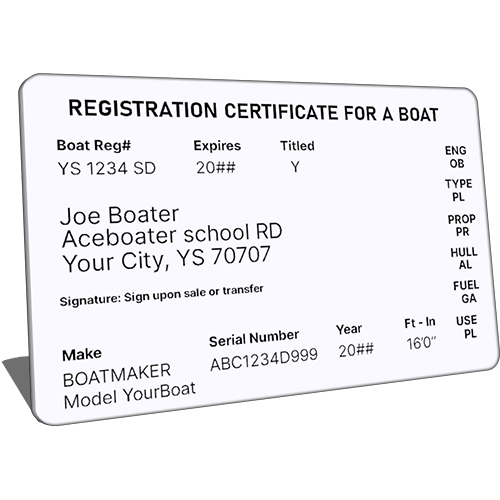Register a Boat in Virginia: Step-by-Step Guide for 2024
Owning a boat in Virginia brings endless possibilities for adventure. But first, you need to register your boat.
Registering a boat in Virginia ensures compliance with state laws and promotes safe boating. Knowing the process can save you time and hassle. This guide will walk you through the steps of boat registration in Virginia. From understanding the necessary documents to the fees involved, we cover everything you need.
Whether you’re a first-time boat owner or just new to Virginia, this information is crucial. Let’s dive into the details to get you out on the water legally and quickly.
Eligibility Criteria
Registering a boat in Virginia requires meeting specific eligibility criteria. Understanding these requirements helps ensure a smooth registration process. This section explains the key elements you need to consider.
Age Requirements
Virginia has specific age requirements for boat registration. The registered owner must be at least 16 years old. This ensures that the owner is responsible and understands boating regulations.
For those under 16, a parent or guardian must register the boat in their name. This rule ensures that young boaters have proper supervision.
Boat Types
Not all boats need registration. Understanding which boat types require registration can save time and effort. Here are some key points:
- Motorboats: All motorboats, regardless of size, must be registered.
- Sailboats: Sailboats over 18 feet in length need registration.
- Personal Watercrafts: Jet skis and other personal watercrafts must be registered.
Non-motorized boats, such as kayaks and canoes, do not require registration. This simplifies the process for those with small, human-powered vessels.
In summary, knowing the age requirements and boat types that need registration helps streamline the process. Make sure to comply with Virginia’s boating laws to enjoy a hassle-free experience on the water.

Credit: aceboater.com
Necessary Documents
Registering a boat in Virginia requires several important documents. These ensure that the boat is legally yours and that all necessary information is recorded correctly. Below, you’ll find a detailed list of the documents you need to gather for a smooth registration process.
Proof Of Ownership
You must show proof that you own the boat. Acceptable documents include a bill of sale, a title, or a manufacturer’s certificate of origin. These documents should clearly state your name and the boat’s details. Make sure the information matches your identification records.
Identification
Provide a valid form of identification. A state-issued driver’s license or a government ID card works best. Ensure your identification is current and matches the name on your proof of ownership. This step helps confirm your identity and prevents fraud.
Application Process
Registering a boat in Virginia involves a few steps. The process is straightforward and ensures your boat is legally recognized. Whether you choose online or in-person submission, understanding the application process is key.
Online Submission
Submitting your boat registration online is convenient. Follow these steps to get started:
- Visit the Virginia Department of Wildlife Resources website.
- Create an account or log in if you already have one.
- Fill out the online registration form with accurate details.
- Upload any required documents, like proof of ownership.
- Pay the registration fee using a credit or debit card.
Once you complete these steps, you will receive a confirmation email. This email includes your registration details and a temporary registration certificate. You can use this certificate until your official one arrives by mail.
In-person Submission
For those who prefer face-to-face interaction, registering your boat in-person is an option. Here’s what you need to do:
- Visit a local Virginia Department of Wildlife Resources office.
- Bring the necessary documents, such as proof of ownership and ID.
- Fill out the registration form provided at the office.
- Submit the form along with the required documents.
- Pay the registration fee using cash, check, or card.
The staff will process your application. You will receive a temporary registration certificate on the spot. Your official certificate will arrive by mail in a few weeks.
Both submission methods ensure your boat is registered correctly. Choose the one that fits your preference and schedule.

Credit: www.hoosierdecal.com
Registration Fees
Registering your boat in Virginia requires understanding the registration fees. These fees vary based on the type and size of the boat. Knowing the cost upfront helps in budgeting for this essential process.
Fee Structure
The fee structure for boat registration in Virginia is straightforward. Below is a table that outlines the fees based on the boat’s length:
| Boat Length | Annual Fee |
|---|---|
| Less than 16 feet | $27 |
| 16 to 19.9 feet | $31 |
| 20 to 26.9 feet | $37 |
| 27 to 39.9 feet | $45 |
| 40 feet and over | $50 |
These fees are for one year of registration. Choose the correct category based on your boat’s length.
Payment Methods
You can pay the registration fees using different methods. The options are designed to make the process easy for all boat owners.
- Online Payment: Use a credit or debit card to pay online.
- Mail: Send a check or money order to the Department of Game and Inland Fisheries.
- In Person: Visit any Department of Game and Inland Fisheries office to pay in person.
Ensuring you have the correct amount ready will make the registration process smooth.
Temporary Registration
Registering a boat in Virginia can sometimes be a lengthy process. To ensure you can get out on the water while your permanent registration is processed, Virginia offers a temporary registration option. This allows you to legally operate your boat during the interim period.
Validity Period
A temporary boat registration in Virginia is valid for 90 days. This period gives you ample time to complete the full registration process. It’s important to remember that this is a one-time temporary registration.
Application Steps
First, gather all necessary documents. These include proof of ownership and identification. Next, visit the Virginia Department of Wildlife Resources (DWR) website. Fill out the temporary registration application form. Ensure all information is accurate and complete.
After filling out the form, submit it along with any required fees. You can do this online or visit a local DWR office. Once your application is processed, you will receive a temporary registration number. Display this number on your boat as instructed.
Remember, you must keep a copy of your temporary registration on your boat at all times. This serves as proof of your legal right to operate the vessel.
Renewal Process
The process of renewing your boat registration in Virginia is straightforward. It ensures your boat remains legally compliant. Regular renewals also help keep your boating experience uninterrupted. This section details the renewal timeline and required documents for a smooth renewal process.
Renewal Timeline
Renew your boat registration every year. The renewal period begins 30 days before the expiration date. Be proactive to avoid penalties. Early renewal ensures you receive your new registration on time.
Required Documents
Gather all necessary documents before starting the renewal process. You will need your current boat registration card. Have your proof of boat ownership ready. Prepare your identification documents. Ensure all information is up-to-date.
Following these steps will simplify the renewal process. Stay organized and renew on time to enjoy your boating adventures without interruptions.
Boat Inspection
Registering a boat in Virginia involves a crucial step: the boat inspection. This ensures your vessel meets all safety and environmental standards. Understanding the inspection process will help you prepare and complete it smoothly.
Inspection Checklist
Before scheduling an inspection, ensure your boat meets all requirements. Here’s a comprehensive inspection checklist to guide you:
- Hull Identification Number (HIN): Ensure it is clear and legible.
- Fire Extinguishers: Must be in working order and easily accessible.
- Life Jackets: One for each passenger, in good condition.
- Navigation Lights: Check for proper functionality.
- Sound Producing Devices: Whistle or horn must be present.
- Visual Distress Signals: Flares or other approved signals.
- Ventilation System: Ensure it works to prevent gas build-up.
Scheduling An Inspection
Once your boat is ready, the next step is scheduling an inspection. Follow these simple steps:
- Contact the Virginia Department of Wildlife Resources.
- Provide your boat’s details and preferred inspection date.
- Prepare all necessary documents, including your boat’s title and registration.
- Ensure your boat is at the designated location on the inspection day.
Remember, passing the inspection is vital for registration. So, thoroughly check everything beforehand. This will save time and ensure a smooth process.
Receiving Registration
After applying to register your boat in Virginia, you will receive your registration. This process ensures your boat is legally recognized. Here’s what you need to know about the receiving registration process.
Processing Time
Processing time for boat registration in Virginia is usually 10 to 15 business days. During this period, the Department of Wildlife Resources (DWR) reviews your application. Make sure all your documents are in order. Any missing information can delay the process.
Obtaining Registration Stickers
Once your registration is approved, you will get your registration stickers. These stickers must be displayed on your boat. They indicate your boat is legally registered in Virginia. Here is how you will receive them:
- Mail Delivery: Stickers are sent to your mailing address.
- Instructions: The DWR provides instructions on where to place the stickers.
Follow the instructions carefully. Incorrectly placed stickers can result in fines. Ensure your boat’s registration number is also displayed. Place it on both sides of the bow, in plain sight.
Common Issues
Registering a boat in Virginia can be a straightforward process. But it’s not uncommon to encounter some issues. Understanding these common problems can help you avoid delays and frustration.
Application Errors
Many boat owners make mistakes on their registration applications. Typos, incorrect information, or missing fields can cause delays. Double-check all details before submitting. Ensure your handwriting is clear if filling out a paper form.
Missing Documents
Another common issue is missing documents. You need to provide proof of ownership, such as a bill of sale. Without this, your application cannot be processed. Gather all required paperwork before starting your application.

Credit: backyarddory.com
Frequently Asked Questions
How Do I Register A Boat In Virginia?
To register a boat in Virginia, you need to complete an application. Submit it with proof of ownership, and pay the required fees.
What Documents Are Required For Boat Registration In Virginia?
You’ll need a completed application, proof of ownership, and payment. Additional documents may be required for specific cases.
How Much Does It Cost To Register A Boat In Virginia?
The cost varies based on the length of the boat. Fees range from $27 to $151.
How Long Is The Boat Registration Valid In Virginia?
Boat registrations in Virginia are valid for three years. You will need to renew it before it expires.
Conclusion
Registering your boat in Virginia is simple and essential. Follow the steps outlined. Ensure you have all the required documents. Visit the appropriate office or register online. This keeps your boating experience smooth and legal. Enjoy the waters of Virginia with peace of mind.
Happy boating!


